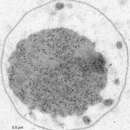en
names in breadcrumbs


Ignicoccus hospitalis is a chemolithoautotrophic, hyperthermophilic Archaeon. It thrives in hydrothermal vents at 90°C, uses molecular hydrogen as electron donor and elemental sulfur as electron acceptor, and produces enormous amounts of H2S (Paper et al., 2007). I. hospitalis is of major interest for scientists in microbiology for two reasons. First, it exhibits an extraordinary cell structure which is unique among the Archaea. In I. hospitalis, an inner membrane separates the cytoplasm from an ‘intermembrane compartment’ which in turn is surrounded by the outer cellular membrane (OCM). The OCM is not only a barrier to the environment but also harbors the hydrogen:sulfur oxidoreductase and the ATP synthase, the two main enzymes for energy conservation (Küper et al., 2010; Huber et al., 2012). Second, I. hospitalis is the only known host for Nanoarchaeum equitans. This tiny Archaeon grows attached to the surface of and retrieves amino acids and lipids from its host. Further metabolic processes in this intimate association are under investigation.